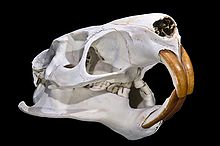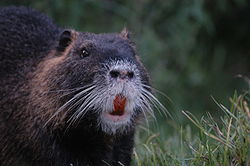- Coypu
-
Coypu or Nutria
Temporal range: Late Pliocene–Recent
Conservation status Scientific classification 
Kingdom: Animalia Phylum: Chordata Class: Mammalia Order: Rodentia Parvorder: Caviomorpha Family: Myocastoridae Genus: Myocastor Species: M. coypus Binomial name Myocastor coypus
(Molina, 1782)The coypu (from the Mapudungun, koypu),[2][3] (Myocastor coypus), also known as the river rat, [4] and nutria, [1][5] is a large, herbivorous, semiaquatic rodent and the only member of the family Myocastoridae. Originally native to subtropical and temperate South America, it has since been introduced to North America, Europe, Asia, and Africa, primarily by fur ranchers.[6] Although it is still valued for its fur in some regions, its destructive feeding and burrowing behaviors make this invasive species a pest throughout most of its range.
There are two commonly-used names in the English language for Myocastor coypus. The name nutria (or local derivatives such as "nutria- or nutra- rat") is generally used in North America and Asia; however, in Spanish-speaking countries, the word nutria refers to the otter. To avoid this ambiguity, the name coypu (derived from the Mapudungun language) is used in Latin America and Europe.[7] In France, the coypu is known as a ragondin. In Dutch it is known as beverrat (beaver rat). In Italy, instead, the popular name is, as in North America and Asia, nutria, but it is also called castorino (little beaver), by which its fur is known in Italy.
Coypus live in burrows alongside stretches of water. They feed on river plants, and waste close to 90% of the plant material while feeding on the stems.[8]
Contents
Taxonomy
The coypu was first described by Juan Ignacio Molina in 1782 as Mus coypus, a member of the mouse genus.[9] The genus Myocastor, assigned in 1792 by Robert Kerr,[10] is derived from the Greek mys and kastor, or "mouse-beaver".[11] Geoffroy, independently of Kerr, named the species Myopotamus coypus,[12] and it is occasionally referred to by this name.
Four subspecies are generally recognized:[9]
- M. c. bonariensis: northern Argentina, Bolivia, Paraguay, Uruguay, southern Brazil
- M. c. coypus: central Chile, Bolivia
- M. c. melanops: Chiloé Island
- M. c. santacruzae: Patagonia
M. c. bonariensis, the subspecies present in the northernmost (subtropical) part of the coypu's range, is believed to be the type of coypu most commonly introduced to other continents.[7]
Appearance
Israeli coypu. The large orange teeth are clearly visible.
The coypu somewhat resembles a very large rat, or a beaver with a small tail. Adults are typically 5–9 kg (11–20 lb) in weight, and 40–60 cm (16–24 in) in body length, with a 30–45 cm (12–18 in) tail. They have a coarse, darkish brown outer fur with a soft under-fur. Two distinguishing marks are the presence of a white patch on the muzzle, and webbed hind feet. They can also be identified by their bright orange-yellow incisor teeth (unlike rats, which have brownish yellow incisors). The nipples of female coypu are high on her flanks. This allows their young to feed while the female is in the water.
Coypu can also be mistaken for another widely dispersed semi-aquatic rodent that occupies the same wetland habitats, the muskrat. The muskrat, however, is smaller, more tolerant of cold climates, and has a laterally flattened tail that it uses to assist in swimming, whereas the tail of a coypu is round. It can also be mistaken for a small beaver, as beavers and coypus have very similar anatomies; beavers' tails are flat and paddle-like, as opposed to the round rat-like tails of coypu.
Commercial and environmental issues
Local extinction in their native range due to overharvest led to the development of coypu fur farms in the late 19th and early 20th centuries. The first farms were in Argentina and then later in Europe, North America, and Asia. These farms have generally not been successful long term investments and farmed coypu often are released or escape as operations become unprofitable.
As demand for coypu fur declined, coypu have since become pests in many areas, destroying aquatic vegetation, marshes, irrigation systems, chewing through human-made items, such as tires and wooden house panelling in Louisiana, eroding river banks, and displacing native animals. Coypu were introduced to the Louisiana ecosystem in the 1930s when they escaped from fur farms that had imported them from South America.[13] Nutria damage in Louisiana became so severe that in 2005, a bounty program was in effect to aid in controlling the animal.[14] In the Chesapeake Bay region in Maryland, where they were introduced in the 1940s, coypu are believed to have destroyed 7,000 to 8,000 acres (2,800 to 3,200 ha) of marshland in the Blackwater National Wildlife Refuge. In response, by 2003, a multi-million dollar eradication program was underway.[15]
Coypu were also introduced to East Anglia, for fur, in 1929; many escaped and damaged the drainage works, and a concerted programme by MAFF eradicated them by 1989.
Coypu meat is lean and low in cholesterol. While there have been many attempts to establish markets for coypu meat, all documented cases have generally been unsuccessful. Unscrupulous entrepreneurs have promoted coypu and coypu farms for their value as "meat", "fur", or "aquatic weed control". In recent years they have done so in countries such as the United States, China, Taiwan and Thailand. In every documented case the entrepreneurs sell coypu "breeding stock" at very high prices. Would-be coypu farmers find that the markets for their products disappear after the promoter has dropped out of the picture.[citation needed]
In the former Soviet republics of Central Asia, specifically Kyrgyzstan and Uzbekistan, Nutria (Russian and local languages Нутрия) are farmed on private plots and sold in local markets as a poor man's meat.[citation needed]
In addition to direct environmental damage, coypu are the host for a nematode parasite (Strongyloides myopotami) that can infect the skin of humans causing dermatitis similar to strongyloidiasis.[16] The condition is also called "nutria itch".[17]
Distribution
Coypus in Germany
view in Full HDThe distribution of coypu tends to expand and contract with successive cold or mild winters. During cold winters, coypu often suffer frostbite on their tails leading to infection or death. As a result, populations of coypu often contract and even become locally or regionally extinct as in the Scandinavian countries and such USA states as Idaho, Montana and Nebraska during the 1980s (Carter and Leonard 2002). During mild winters, their ranges tend to expand northward. For example in recent years range expansions have been noted in Washington State and Oregon (Sheffels and Sytsma 2007).
- Distribution by continent (click to enlarge)
References
- Sandro Bertolino, Aurelio Perrone, and Laura Gola "Effectiveness of coypu control in small Italian wetland areas" Wildlife Society Bulletin Volume 33, Issue 2 (June 2005) pp. 714–72.
- Carter, Jacoby and Billy P. Leonard: "A Review of the Literature on the Worldwide Distribution, Spread of, and Efforts to Eradicate the Coypu (Myocastor coypus)" Wildlife Society Bulletin, Vol. 30, No. 1 (Spring, 2002), pp. 162–175.
- Carter, J., A.L. Foote, and L.A. Johnson-Randall. 1999. Modeling the effects of nutria (Myocastor coypus) on wetland loss. Wetlands 19(1):209-219
- Lauren E. Nolfo-Clements: Seasonal variations in habitat availability, habitat selection, and movement patterns of Myocastor coypus on a subtropical freshwater floating marsh. (Dissertation) Tulane University. New Orleans. 2006. ISBN 0-542-60916-9
- Sheffels, Trevor and Mark Systma. "Report on Nutria Management and Research in the Pacific Northwest" Center for Lakes and Reservoir Environmental Sciences and Resources, Portland State University. December 2007. Available on-line: http://www.clr.pdx.edu/docs/CLR_nutria_report.pdf.
Notes
- ^ a b Lessa, E., Ojeda, R., Bidau, C. & Emmons, L. (2008). Myocastor coypus. In: IUCN 2008. IUCN Red List of Threatened Species. Downloaded on 6 January 2009.
- ^ Coypu. The American Heritage Dictionary of the English Language, Fourth Edition, 2006. Houghton Mifflin
- ^ Muñoz Urrutia, Rafael, ed (2006) (in Spanish). Diccionario Mapuche: Mapudungun/Español, Español/Mapudungun (2nd ed.). Santiago, Chile. pp. 155. ISBN 956-8287-99-X.
- ^ Castorologia: or The history and traditions of the Canadian beaver, Horace T. Martin, p.35
- ^ "Myocastor coypus". http://www.itis.gov/servlet/SingleRpt/SingleRpt?search_topic=TSN&search_value=180402. Retrieved 23rd September 2011.
- ^ LeBlanc, Dwight J. 1994. Prevention and Control of Wildlife Damage – Nutria. Animal and Plant Health Inspection Service.
- ^ a b Carter, Jacoby. Worldwide Distribution, Spread of, and Efforts to Eradicate the Nutria (Myocastor coypus) – South America. United States Geological Survey. January 29, 2007. Retrieved on September 4, 2007.
- ^ 6. Grace, James B.; Marx, B.D.; Taylor K.L. The effects of herbivory on neighbor interac-tions along a coastal marsh gradient. American Journal of Botany, Volume 84, Number 5 (May 1997), pp. 709-715.
- ^ a b C. A. Woods, L. Contreras, G. Willner-Chapman, H. P. Whidden. 1992. Mammalian Species: Myocastor coypus. American Society of Mammalogists, 398: 1-8.
- ^ ITIS Report. "ITIS Standard Report: Myocastor". http://www.itis.gov/servlet/SingleRpt/SingleRpt?search_topic=TSN&search_value=180401. Retrieved September 5, 2007.
- ^ Nutria Biology. Nutria.com. 2007. Retrieved on September 5, 2007.
- ^ ITIS Report. "ITIS Standard Report: Myopotamus". http://www.itis.gov/servlet/SingleRpt/SingleRpt?search_topic=TSN&search_value=203538. Retrieved December 19, 2007.
- ^ http://www.nwrc.usgs.gov/factshts/020-00.pdf
- ^ Nutria control program
- ^ "A Plague of Aliens" Feb/Mar 2003 edition of National Wildlife magazine, published by the National Wildlife Federation, article by Laura Tangley; accessed online December 8, 2006.
- ^ eMedicine: Strongyloidiasis
- ^ Bonilla et al. "Nutria Itch" in Archives of Dermatology. Vol. 136 No. 6, June 2000
External links
- History, distribution and spread of coypu introductions worldwide; efforts to eradicate with links to other nutria sites
- The Effect of Nutria on Marsh Loss in the Lower Eastern Shore of Maryland undated USGS report
- Portland State University Report on coypus in the Pacific Northwest of North America.
- Species Profile- Nutria (Myocastor coypus), National Invasive Species Information Center, United States National Agricultural Library. Lists general information and resources for Nutria.
Categories:- IUCN Red List least concern species
- Hystricognath rodents
- Herbivorous animals
- Invasive animal species
- Mammals of Argentina
- Mammals of Asia
- Mammals of Bolivia
- Mammals of Brazil
- Mammals of Chile
- Mammals of Europe
- Mammals of North America
- Mammals of Paraguay
- Mammals of South America
- Mammals of Uruguay
- Invasive animal species in the United States
Wikimedia Foundation. 2010.










